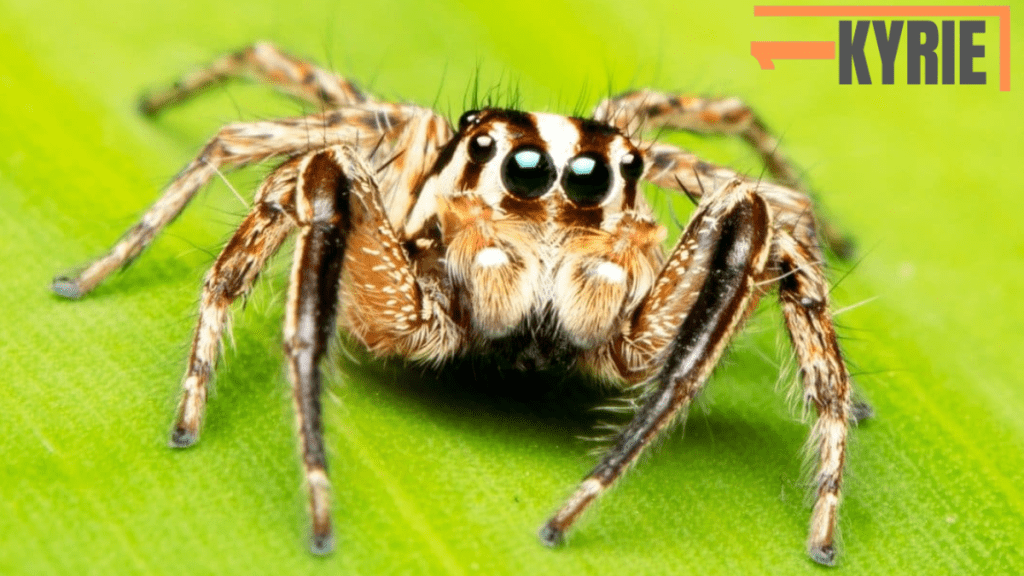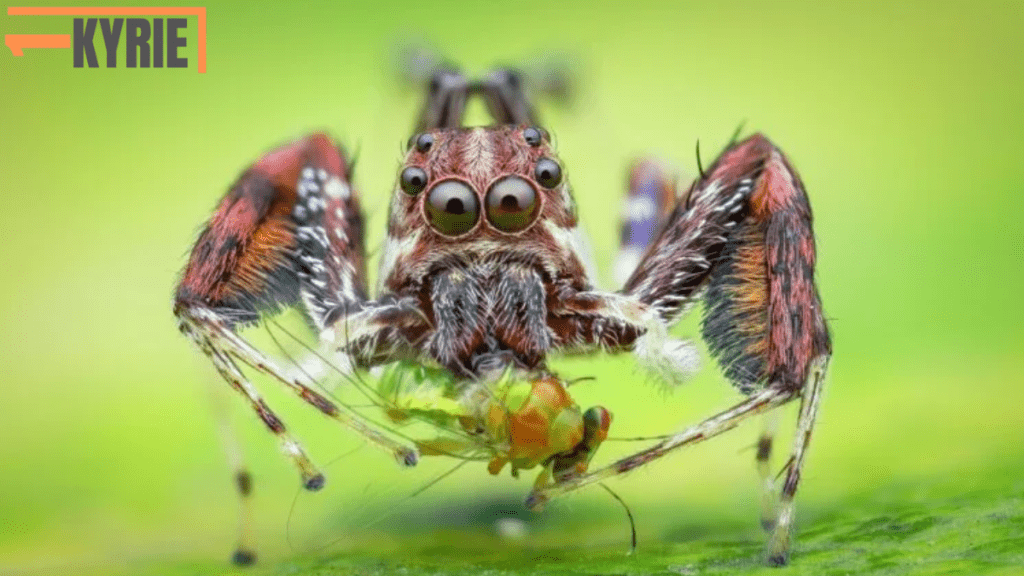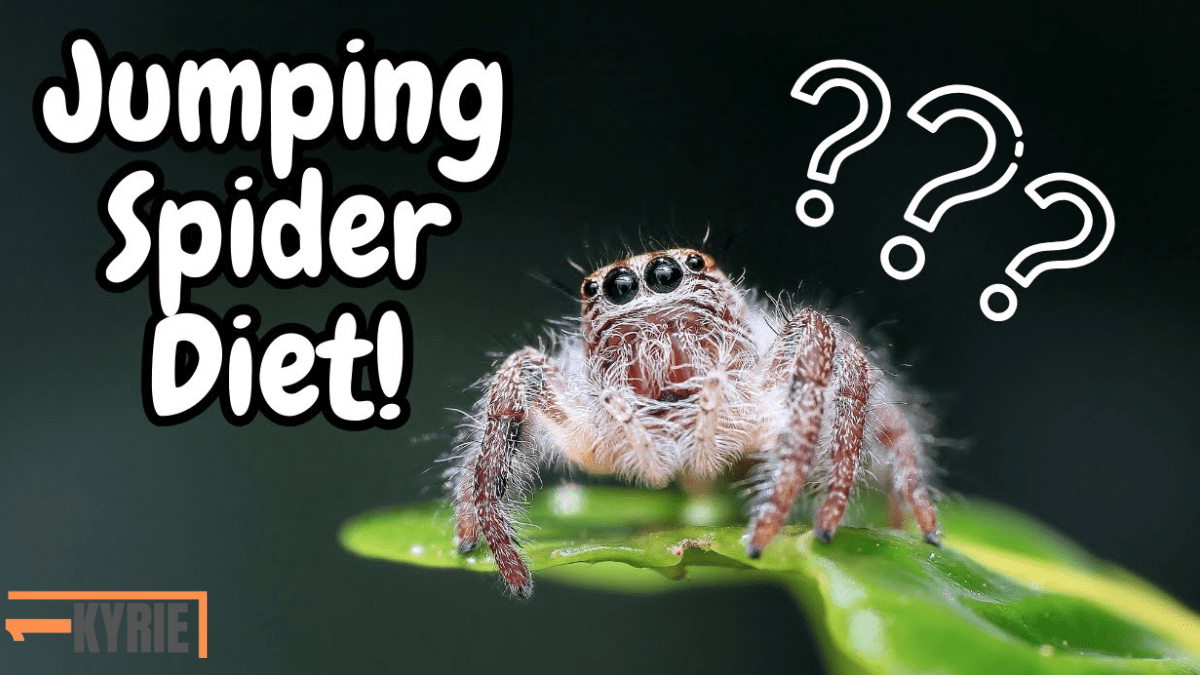Table of Contents
What do Jumping Spiders Eat? Jumping spiders are one of the most fascinating creatures in the arachnid world. These small, quick spiders can jump really well. This skill helps them catch prey like fruit flies and dubia roaches. Their jumping ability makes them interesting pets. So, what do jumping spiders eat? Their diet primarily consists of small arthropods, such as insects, other spiders, and even tiny arachnids. Let’s explore jumping spiders. We’ll look at how they hunt, what they eat, and their behaviors.
Understanding the jumping spider’s hunting techniques.

What Do Jumping Spiders Eat? Jumping spiders are expert hunters, relying on their sharp vision and remarkable agility. Unlike web-building spiders, they don’t capture prey using webs. Instead, they actively hunt and pounce on their prey, demonstrating impressive stalking skills. Their big, forward-facing eyes help them see movement from far away. Once they spot a target, they move in slowly and carefully, like a jumper ready to leap.
When they get close, they jump toward their prey with precision. They use a silk line to catch themselves if they miss the jump, much like they do with pinhead crickets. Their great eyesight, skilled stalking, and quick leaping make them top hunters.
A wide variety of prey.
One of the most interesting aspects of jumping spiders is their varied diet. These spiders are generalist predators. They eat almost anything they can catch. This includes jumping spiders that hunt crickets and fruit flies. Insects make up the bulk of their diet, and jumping spiders are particularly fond of small flying insects such as flies, moths, and mosquitoes. They will also feast on ants, beetles, and other small arthropods that come within their reach.
What Do Jumping Spiders Eat? Occasionally, jumping spiders will target other spiders as prey, including web-building species. They are even known to invade the webs of other spiders to capture the unsuspecting residents. This adaptability in prey selection is a key reason why jumping spiders are such successful predators.
What do jumping spiders eat other arachnids?
What do Jumping Spiders Eat? Jumping spiders are not limited to eating just insects. They are opportunistic feeders and will also consume other arachnids when the opportunity arises. Mites and tiny scorpions are also on the menu for these agile hunters. Jumping spiders might not search for these creatures. But, they will gladly eat feeder insects like mealworms when they are around.
Jumping spiders thrive in many habitats. They adapt well to different environments and use various food sources. This includes dubia roaches and mealworms. From gardens to homes, these spiders can find a suitable food source almost anywhere.
Check out this one: why-do-babies-like-ceiling-fans
How often what do jumping spiders eat?
Jumping spiders have high metabolic rates. They need to eat often to keep their energy up. Smaller spiders, especially juveniles, often need to eat more than larger adults. This is because they use more energy. As active hunters, they may hunt daily or every few days, depending on their size and age.
The availability of prey, such as mealworms and crickets, is a significant factor that influences how often a jumping spider eats. If they’re in a place with an abundance of insects, such as pinhead crickets, they may feed more frequently. When prey is hard to find, jumping spiders can survive without food for a long time. This shows how adaptable they are to various conditions.
Are jumping spiders scavengers?
Jumping spiders are great hunters. They also scavenge for dead insects when they can. However, scavenging is not their primary feeding behavior; they prefer live prey like crickets and mealworms. Jumping spiders are more efficient at hunting live prey, as they rely on fresh food for optimal nutrition.
Dead insects, while sometimes consumed, are not as nutritionally rich as live prey. Additionally, scavenging carries risks, as dead insects can carry disease or may be in poor condition. Jumping spiders like to hunt live prey, such as crickets and fruit flies. But if food is hard to find, especially after they hatch, they will scavenge.
The Role of Silk in Their Feeding Habits
Jumping spiders don’t use webs to catch food. They do use silk when hunting and feeding. This silk is important for their survival, especially during molting. The silk serves as a safety line during their jumps, preventing them from falling if they miss their target. Additionally, jumping spiders use silk to create shelters or to secure their prey, such as dubia roaches, once it has been captured.
Silk also plays a role in their feeding process, as some species may wrap their prey in silk to prevent it from escaping. This allows them to consume their food in a secure, controlled manner.
Read more: Why Are Popcorn Ceilings Bad: The Health Hazards of Asbestos in Popcorn Ceilings
Feeding Process: What Do Jumping Spiders Eat?
Once a jumping spider has captured its prey, such as a cricket or a mealworm, the feeding process begins. The spider delivers a paralyzing bite using its fangs, injecting venom into its prey. The venom breaks down the prey’s soft tissues. It liquefies them, allowing the spider to consume the meal. This is especially true for jumping spiders like Phidippus and other species.
Jumping spiders don’t chew their food like humans. They release digestive enzymes that break down the prey’s insides. This helps them eat feeder insects. The spider then sucks up the resulting fluid through its straw-like mouthparts. This method of external digestion ensures they can extract the maximum nutrients from their prey.
Jumping Spiders and Their Feeding Frequency
Jumping spiders need to eat often. Their diet includes fruit flies and dubia roaches. This helps them maintain their high energy levels. Juvenile spiders may eat more often, while adults may go a few days between meals. This frequency depends on several factors. These include the spider’s size, age, activity level, and how much prey is available in its environment.
Jumping spiders are most active during the warmer months, which also affects how often they feed. During the cooler months, they may become less active and may not hunt as often, depending on the conditions in their substrate.

The Impact of Their Diet on Ecosystems
Jumping spiders, including pet jumping spiders, play an important role in their ecosystems. Eating different types of insects helps keep insect populations in check. This benefits gardens, homes, and nature. Their hunting habits can reduce the number of pests, making them beneficial creatures in many habitats.
Also, their skill in hunting and adapting to different environments keeps the food chain balanced. This shows how adaptable various spider species can be. Jumping spiders are predators. They help control the populations of feeder insects, such as crickets and mealworms. They also eat other small creatures.
Check out this one: what do jumping spiders eat
Why Are Jumping Spiders Important?
Jumping spiders are incredible creatures with unique feeding and hunting behaviors. They are not only skilled hunters but also serve a vital role in ecosystems by controlling insect populations. Their diverse diet includes insects like crickets, arachnids, and even other spiders. This shows their adaptability and versatility, especially in species like Phidippus.
Understanding what jumping spiders eat is essential for appreciating their role in nature. These amazing predators are not just creepy crawlers. They are skilled hunters that help keep their environments healthy and balanced. Jumping spiders, found in gardens or nearby forests, help control insect numbers. Even tiny spiderlings can make a big difference.

